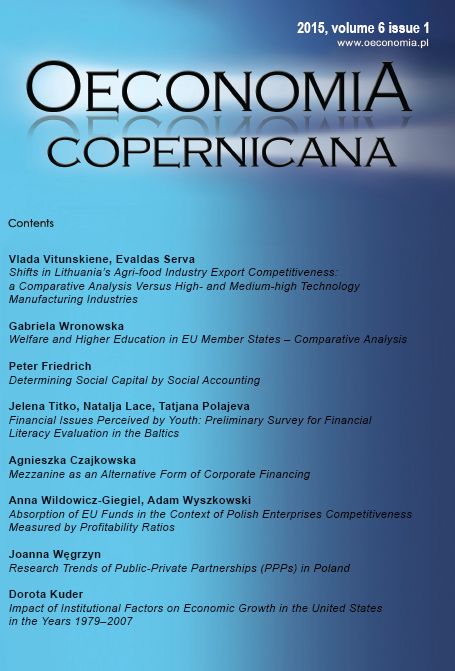Shifts in Lithuania?s agri-food industry export competitiveness: a comparative analysis versus high- and medium-high technology manufacturing industries
DOI:
https://doi.org/10.12775/OeC.2015.001Keywords:
agri-food, manufacturing, end-use category, exportAbstract
Given the rising importance of global value chain, this paper analyses long-run shifts in export competitiveness of Lithuania?s agri-food industry compared to high and medium-high-technology industries in the context of Lithuania?s export vertical specialization. The combination of two complementary parameters of competitiveness i.e. Balassa (1965) index of Revealed Comparative Advantage (RCA) and Total Effect (TE) index proposed by Nyssens and Poullet (cited in Amador and Cabral, 2008, p. 202) were used. The matrix of both indexes builds on the scheme of analytical tool ?products mapping? suggested by Widoto (2009). Our analytical tool is applied for the empirical analysis of export flows of goods by three end-use categories within aggregate agri-food industry the same as four manufacturing industries classified by R&D intensities, i.e. high-, medium-high-, medium-low- and low-technology industries. The OECD?s STAN Bilateral Trade Database by Industry and End-use category at the same time was applied to empirical analysis. The findings based on detailed analysis indicated significant differences in export competitiveness and its gains or losses in a long-term period among different reporting Lithuania?s industries and different goods by end-use category.
Downloads
References
Backer, K., & Miroudot, S. (2012). Mapping global value chains. Paper prepared for the Final WIOD Conference: Causes and Consequences of Globalization, Groningen, The Netherlands, April 24-26.
Balassa, B. (1965). Trade liberalization and revealed comparative advantage. The Manchester School of Economic and Social Studies, 33. New York: Cambridge University Press.
Banterle, A. (2005). Competitiveness and agri-food trade: an empirical analysis in the European Union. In 11th Congress of the EAAE ?The Future of Rural Europe in the Global Agri-Food System?. Copenhagen.
Bojnec, Š., & Fertő, I. (2014). Agri-food exports from European Union Member States using constant market share analysis. Studies in Agricultural Economics, 116. http://dx.doi.org/10.7896/j.1404.
Chen, K. Z., & Duan, Y. (2001). Competitiveness of Canadian agri-food exports against competitors in Asia: 1980-97. Journal of International Food and Agribusiness Marketing, 11(4). http://dx.doi.org/10.1300/J047v11n04_01.
Cheptea, A., Fontagné, L, & Zignago, S. (2014). European export performance. Review of World Economics. 150(1). http://dx.doi.org/10.1007/s10290-013-0176-z.
Droždz, J., & Miškinis, A. (2011). Rusijos, Baltarusijos ir Kazachstano muit? sąjungos žem?s ?kio ir maisto produkt? santykinio pranašumo vertinimas. Pinig? studijos, 15(2).
Durand, M., & Giorno, C. (1987). Indicators of international competitiveness: conceptual aspects and evaluation. OECD economic studies, 9(2).
Feenstra, R. C. (1998). Integration of Trade and Disintegration of Production in the Global Economy. The Journal of Economic Perspectives, 12(4). http://dx.doi.org/10.1257/jep.12.4.31.
Ferto, I., & Hubbard, L.J. (2003). The Dynamics of Agri?Food Trade Patterns ? The Accession Countries? Case. In: Contributed Paper Presented at the International Conference Agricultural Policy Reform and the WTO: where are we heading? Capri. June 23?26.
Henderson, J., Dicken, P., Hess, M., Coe, N., &Yeung, H. W. C. (2002). Global production networks and the analysis of economic development. Review of international political economy, 9(3). http://dx.doi.org/10.1080/09692290210 150842.
Hinloopen, J., & Van Marrewijk, C. (2001). On the empirical distribution of the Balassa index. Weltwirtschaftliches Archiv, 137(1). http://dx.doi.org/10.1007 /BF02707598.
Ishchukova, N., & Smutka, L. (2013). Comparative Advantage: Products Mapping of the Russian Agricultural Exports. AGRIS on-line Papers in Economics and Informatics, 5(3).
Jasinskait?, S., & Masalskis K. (2001). Pramon?s konkurencingumas ES. Lietuvos ekonomikos apžvalga, Geguž?.
Jucevičius, R., Vitunskien?, V., & Šajeva, S. (2010). Lietuvos maisto produkt? gamybos pramon?s konkurencingumas: mokslo studija. Kauno technologijos universitetas. Kaunas.
Kanta Ray, P., Ida, M., Suh, C. S., & Rhaman, S. U. (2004). Dynamic Capabilities of Japanese and Kore-an Enterprises and the ?Flying Geese?of International Competitiveness. Asia Pacific Business Review, 10(3-4).
Kasahara, S. (2004). The Flying Geese Paradigm: A critical study of its application to East Asian regional development. Discussion Paper No. 169, United Nations Conference on Trade and Development, April.
Neilson, J., Pritchard, B., & Yeung, H. W. C. (2014). Global value chains and global production networks in the changing international political economy: An introduction. Review of International Political Economy, 21(1).
O?Brien, D. (2010). Measuring Ireland?s Price and Labour Cost Competitiveness. Bulletin trimestriel.
OECD. (2011). Global Value Chains: Preliminary Evidence and Policy Issues, DSTI/IND3, Paris, OECD.
OECD. (2014). OECD Bilateral Trade Database by Industry and End-use (BTDIxE), edition 2013. Directorate for Science, Technology and Industry, Division for Economic Analysis and Statistics.
Oelgemoller. J. (2013). Revealed comparative advantages in Greece, Ireland, Portugal and Spain. Intereconomics. 48(4). http://dx.doi.org/10.1007/s10272-013-0466-7.
Rimkus, V., & Karlait?, D. (2011). Tendencies of the Lithuanian dairy produce and export. Business Systems and Economics, 1(1).
Saboniene, A., Masteikiene, R., & Venckuviene, V. (2013). Lithuania?s Export Specialization According to Technological Classification. Mediterranean Journal of Social Sciences, 4(11). http://dx.doi.org/10.5901/mjss.2013.v4n11p346.
Sarker, R., & Ratnesena, S. (2014). Revealed Comparative Advantage and Half-A-Century Competitiveness of Canadian Agriculture: A Case Study of Wheat, Beef and Pork Sectors (No. 165675). http://dx.doi.org/10.1111/cjag.12057.
Startien?, G., & Remeikien?, R. (2014). Evaluation of Revealed Comparative Advantage of Lithuanian Industry in Global Markets. Procedia-Social and Behavioral Sciences, 110. 428-438. http://dx.doi.org/10.1016/j.sbspro.2013.12.887.
Together, G. (1990). A Report to Ministers of Agriculture Task Force on Competitiveness in the Agri-Food Industry, Larry J. Martin (Task Force Chairperson). Working Group Reports.
Vitunskien?, V., & Serva, E. (2006). Atskleistasis santykinis pranašumas: teorinis poži?ris ir analiz? Lietuvos pieno sektoriuje ES-15 atžvilgiu. Ekonomika, 73.
Vitunskien?, V., & Serva, E. 2005. Atskleistasis santykinis pranašumas Lietuvos pieno sektoriuje. Vagos, 68 (21).
Widodo, T. (2009). Comparative advantage: theory, empirical measures and case studies. Review of Economic and Business Studies, II( 2).
Zhu, S., Yamano, N., & Cimper, A. (2011). Compilation of bilateral trade database by industry and end-use category (No. 2011/6). OECD Publishing.






